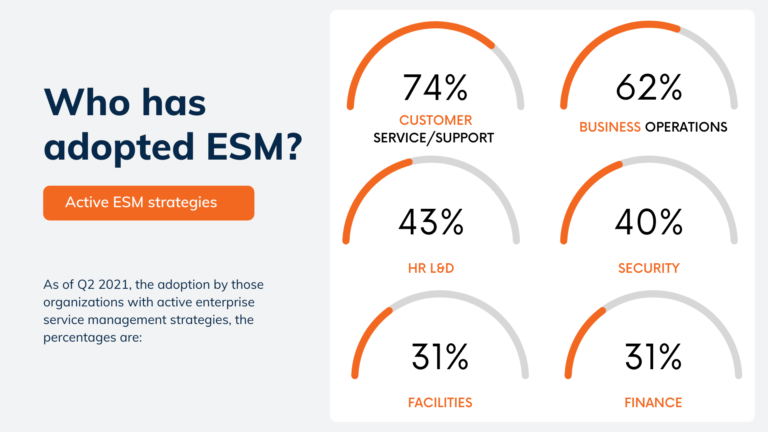

Although not considered digital transformation proper, enterprise service management (ESM) plays an important role in how businesses manage and deliver services.
Although not considered digital transformation proper, enterprise service management (ESM) plays an important role in how businesses manage and deliver services
ESM is considered a “next-generation” Service Management platform. It adopts the same set of principles that govern IT Service Management and extends functionality to business-specific use cases outside of the IT realm. These can include Facilities Management, HR, procurement, and many others. While some executives consider it a function under the “digital transformation” umbrella, others know it as “service management” or “digital workflow enablement.”
However you define it, ESM produces big benefits for companies (which is why 68% of organizations had ESM strategies in the works in Q2 of 2021). Below, we review a few of the biggest benefits of ESM and why so many businesses consider it a strategic force for improvement.
Consistent Delivery of New Services
ESM allows implementation of new processes (like self-help portals or internal service desk functions) that boost efficiency and allow better alignment between ITSM and IT Operations Management (ITOM) functions.
The platform enables new functions in a consistent framework across standards and processes to make sure that all employees are on the same page. This approach limits the amount of decision-making required from the individual and reduces variability across processes—important targets for any business.
Process Automation
Automation of manual and time-consuming processes is a top use for ESM. A 2020 survey of global business leaders found that 66% of companies were piloting solutions for process automation, and 31% had fully automated at least one function.
ESM allows companies to automate operation management through new ways of performance monitoring. It applies continuous improvement strategies and even integrates with other tools. A great example is employee onboarding. ESM is able to streamline processes across several functional areas and help employees become productive day-one.
Self-Service Mastery & Productivity
Related to consistent service delivery automation, ESM allows for better efficiency through self-service tools and portals. These solutions allow users to solve common issues without the need for personnel input, reduces lost worker productivity by 33% and reduces downtime for employees by as much as 90%.
Streamlined Governance & Control
Readers may notice a theme in how ESM allows for better internal consistency across the board. This applies to functions such as access control and governance as much as self-service automation. As ESM allows businesses to better define service controls across the enterprise, it’s easier to support tasks like access control and to ensure that all requests logged through the ESM portal are legitimate.
Reduced Operational Costs
With all of the above in mind, it’s easy to see how ESM reduces operational costs as it reclaims lost productivity and reduces time spent on manual tasks. Modern ESM also performs faster resolution with lower administrative overhead, which decreases time by 22% or more.
ESM: A Necessary Business Function
Given that businesses these days are being tasked to do more with less, cost saving efficiency tools like ESM are more necessary than ever. Approximately 70% of enterprise customers saw ROI by deploying solutions that expanded their core ITSM. The unification of digital services on a single platform can create substantial value.
